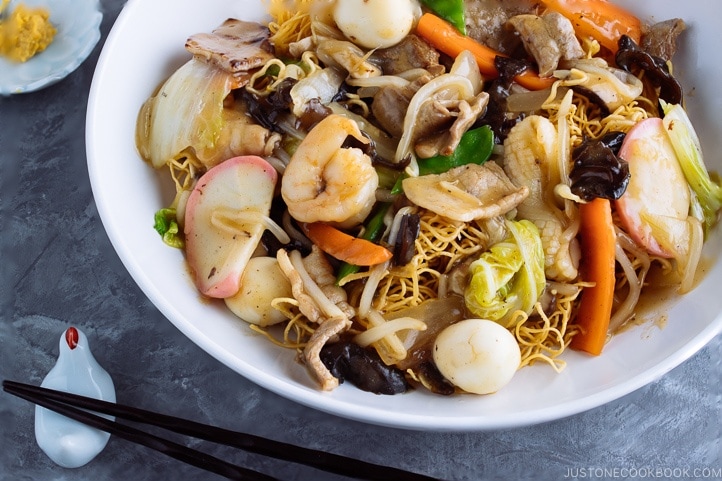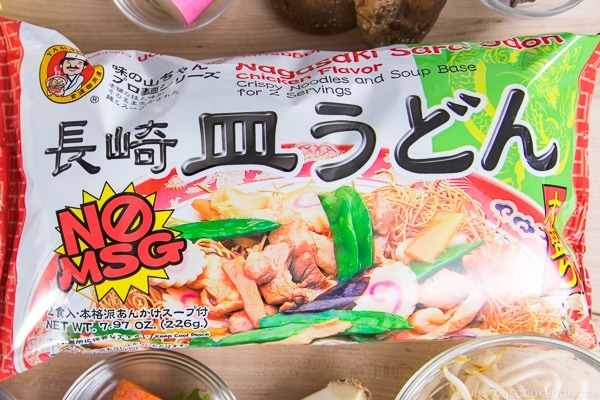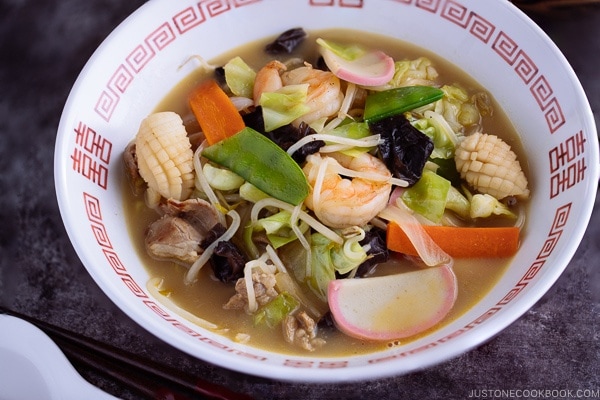
A Japanese take on the popular Chinese crispy noodles with saucy seafood and vegetables. Forget take-out and make this Nagasaki Sara Udon tonight instead!

Since I was small, I’ve always loved foods that have a crispy and crunchy texture, and Sara Udon (皿うどん) was no exception. This noodle recipe is the Japanese version of the classic Chinese dish – Crispy Noodles with Seafood 海鮮炒麵, featuring stir-fried seafood, pork, kamaboko fish cake, cabbage, bean sprouts, and other colorful vegetables, atop a bed of pan-fried egg noodles.
Sara Udon was always my first favorite at the Japanese-style Chinese restaurant while the other kids would go for Chahan (炒飯 – fried rice) or Gyoza. When the plate of noodles served in front of me, I made sure to devour the crispy bits of noodles as fast as possible before they get wilted from the remaining heat of the sauce on top.
Watch How to Make Nagasaki Sara Udon
A Japanese take on the popular Chinese crispy noodles with saucy seafood and vegetables. Forget take-out and make this Nagasaki Sara Udon tonight instead!
What is Sara Udon?
Sara udon (皿うどん), literally means “plate noodles” in Japanese. It consists of two parts: crispy fried noodles on the bottom and stir fried seafood, pork, and vegetable sauce on top. All the ingredients in the soup are thickened with a small amount of slurry, so they coat well with the noodles.
By now you’re probably wondering where is the “udon noodles” as it’s called Sara Udon.
Well, the definition of udon can be a little ambiguous at times. Before it was called Sara Udon, the dish used to be one of the versions of Champon – a noodle dish introduced by a Chinese restaurant Shikairō (四海楼) back in Nagasaki, where Champon was first created. If you are not familiar with Champon, you can read my post first.
Thick Champon noodles, which look slightly like a thinner version of udon noodles, were served on a plate, and the ingredients were served over the noodles without soup for the ease of home delivery. Since the noodles were served on the plate, this version was eventually named Sara (“plate”) Udon instead of Champon.

Later on, thin noodles that are fried to crispy were introduced and became another version of Sara Udon. The soup thickened with slurry and that has become the mainstream of what Sara Udon is nowadays.
These days you can find Sara Udon being served with two different styles of noodle. The first style is similar to Cantonese-style crispy chow mein (or more notably Hong Kong Crispy Chow Mein) where thin egg noodles are fried in oil till crispy. The second style uses thicker Chinese noodles that are pan-fried like Chanpon noodles. Both are common in Nagasaki, but Sara Udon outside of Nagasaki area mostly use thin crispy noodles.

Key Ingredients to Make Sara Udon
1. Crispy Noodles
Where to find crispy noodles? I found this Nagasaki Sara Udon package in my local Japanese grocery store Nijiya Market and I use only the noodles and skip the soup base. If you don’t have a Japanese market nearby, you can visit a Chinese grocery store and look for crispy noodles in a bag.

Crispy noodles in Sara Udon package
If you prefer to make your own, you can deep fry or pan fry the Hong Kong noodles in your wok.
2. Your Choice of Seafood, Pork, and Vegetables
I have included most of the ingredients that come with Sara Udon in this recipe. They are:
- Pork belly slices (no, it’s not bacon. It’s the pork cut used for making bacon. You can find it in Japanese, Chinese, Korean, or Mexican grocery stores. If they only sell a block of pork belly, slice your own following my tutorial).
- Shrimp
- Squid
- Clams (I skipped them in this recipe since it takes time to de-grit clams)
- Kamaboko fish cakes
- Quail eggs
- Onion
- Carrot
- Cabbage
- Bean sprout
- Snow peas
- Wood ear mushrooms
This may look like a daunting list of ingredients, so you can certainly simplify the ingredients or switch things up with whatever you have on hand.
3. Chicken Stock/Broth Base Soup
The soup base is chicken stock/broth. You can use homemade chicken stock if you have it around (Here’s my chicken stock recipe), or use packaged chicken stock. Each package comes with different saltiness so please adjust the soup base accordingly. It’s important to keep a spoon around and always taste before you finish cooking!
To make a vegetarian or vegan-friendly version of Sara Udon, please use a vegetable broth and “Vegetarian Mushroom Flavored Stir-Fry Sauce” instead of oyster sauce. For protein, you can easily use deep-fried tofu or pan-fried tofu in place of seafood.

Sara Udon on Kodoku no Gurume
I was inspired to make this noodle recipe after watching the popular Japanese TV drama – Kodoku no Gurume (孤独のグルメ) [Season 6: Episode 7]. The protagonist Gorō-san had a bowl of Sara Udon at Nagasaki Hanten (長崎飯店) in Shibuya. It was exactly the noodles I used to order at Chinese restaurants growing up. So I got to share my version of this recipe!
For those of you who are not familiar with Kodoku no Gurume, the main character Gorō is a Japanese salaryman who is in sales. As a salesperson, Gorō travels across Japan for his work and on each business trip he visits various restaurants and street booths to sample the local cuisine. Each chapter features a different place and dish.

This TV drama has been around for years in Japan, and currently Season 7 is on air. Unfortunately, it is not available on Netflix like Midnight Diner: Tokyo Stories here in the States, but it’s available on Netflix Japan and other sources. Maybe Netflix USA will pick it up if there’s enough interest for the drama. You can find some of the older seasons available in DVD format on Amazon.
Whether you have access to Kodoku no Gurume or not, I want to share all the delicious foods the main character Gorō-san enjoyed in the show and I hope you would join me in cooking up these dishes.
Kodoku no Gurume Recipes Series on Just One Cookbook

Don’t want to miss a recipe? Sign up for the FREE Just One Cookbook newsletter delivered to your inbox! And stay in touch on Facebook, Google+, Pinterest, and Instagram for all the latest updates.
Sara Udon

Sara Udon is a Japanese take on the popular Chinese crispy noodles with saucy seafood and vegetables. Skip take-out and recreate this noodle dish at home!
- 4 oz sliced pork belly ((113 g))
- 2 oz shrimp ((57 g))
- 1.6 oz squid ((45 g))
- 3 tsp sake ((1 tsp each for pork, shrimp, and squid))
- 1 tsp soy sauce ((for pork))
- 2 Tbsp dried wood ear mushrooms ((4 g))
- 6 quail eggs
- ⅓ kamaboko (fish cake) ((25 g))
- ¼ onion
- 2 inches carrot ((5 cm))
- 3 leaves napa cabbage
- 2 shiitake mushrooms
- 4 snow peas
- 1 Tbsp sesame oil ((for cooking))
- 4 oz bean sprouts ((113 g))
- ⅛ tsp white pepper
- 2 tsp kosher salt ((Adjust based on ingredients – if you add clams, use less salt. If you use saltier chicken stock with MSG, use less or no sugar, etc))
Sauce
- 1 ½ cup chicken stock/broth ((360 ml))
- 1 Tbsp oyster sauce
- ½ Tbsp soy sauce
- 2 tsp sugar
Slurry
- 2 Tbsp potato starch/corn starch
- 6 Tbsp water
To serve
- 2 servings deep fried crispy noodles
- Janese karashi hot mustard
- Rice vinegar
- Gather all the ingredients.

To Make the Sauce
- Combine 1 ½ cup chicken broth, 1 Tbsp oyster sauce, ½ Tbsp soy sauce, and 2 tsp sugar. Mix all together well.

To Prepare Ingredients
-
Add 1 tsp sake to pork, shrimp, and squid to remove any odor.

- Add 1 tsp soy sauce to the pork and combine well. Set aside.

- Rehydrate the dried wood ear mushrooms and cut into smaller pieces.

-
Bring a small pot of water to a boil. Take out the quail eggs from the refrigerator and carefully place in the boiling water. Reduce the heat to medium-low and cook for 3 minutes.

- Once they are finished cooking, place the quail eggs in iced water. Once cool, remove the shell.

- Score the squid in the crisscross pattern by making parallel diagonal lines. Make sure not to cut it all the way through. Thinly slice the kamaboko fish cake.

- Cut the onion into wedges and then cut in half widthwise.

- Thinly slice the carrot into slabs. Then cut them in half lengthwise.

- Cut the napa cabbage into roughly 2 inch pieces widthwise and then cut them in half lengthwise.

- Remove the stems of shiitake mushrooms and slice the caps.

- Remove the strings from snow peas and cut in half.

- To make the slurry, in a small bowl combine 6 Tbsp water (make sure it’s not warm/hot water) and 2 Tbsp potato/corn starch and whisk well together.

- Carefully loosen the crispy noodles on the plates.

To Stir Fry
- Heat the wok on medium-high. Once the wok is hot, add 1 Tbsp sesame oil and the pork.

- Separate the pork and add the shrimp and squid. Stir to combine.

- When the meat is no longer pink, add the onion. Stir well until coated with oil.

- Add the hard bottom part of napa cabbage and wood ear mushrooms.

- Add the carrot, leafy parts of napa cabbage, and bean sprouts.

- Add the shiitake mushrooms, kamaboko fish cakes, and snow peas.

- Add the soup into the wok and mix well. Add the quail eggs.

- Season with ⅛ tsp white pepper and 2 tsp kosher. Taste the soup to make sure the flavor is good.

- Whisk the slurry one more time and add to wok. Mix well.

- Pour over the crispy noodles and serve with karashi mustard and rice vinegar on the side. Enjoy!

Recipe by Namiko Chen of Just One Cookbook. All images and content on this site are copyright protected. Please do not use my images without my permission. If you’d like to share this recipe on your site, please re-write the recipe in your own words and link to this post as the original source. Thank you.
Resource : https://ift.tt/2vMxpFu




No comments:
Post a Comment